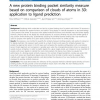420 search results - page 21 / 84 » A graphical model for predicting protein molecular function |
APBC
2004
13 years 9 months ago
2004
Transcription factors play essential role in the gene regulation in higher organisms, binding to multiple target sequences and regulating multiple genes in a complex manner. In or...
AIIA
2007
Springer
13 years 11 months ago
2007
Springer
One of the aims of modern Bioinformatics is to discover the molecular mechanisms that rule the protein operation. This would allow us to understand the complex processes involved i...
BMCBI
2008
13 years 8 months ago
2008
Background: Protein structure prediction and computational protein design require efficient yet sufficiently accurate descriptions of aqueous solvent. We continue to evaluate the ...
RECOMB
2003
Springer
14 years 8 months ago
2003
Springer
We develop a new framework for inferring models of transcriptional regulation. The models in this approach, which we call physical models, are constructed on the basis of verifiab...
BMCBI
2010
13 years 8 months ago
2010
Background: Predicting which molecules can bind to a given binding site of a protein with known 3D structure is important to decipher the protein function, and useful in drug desi...

